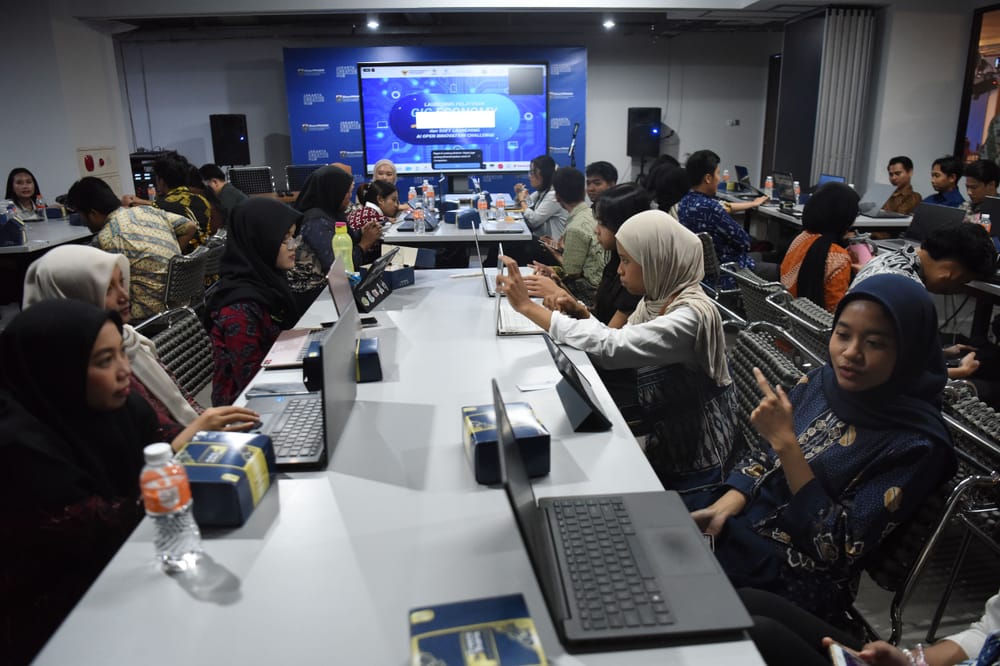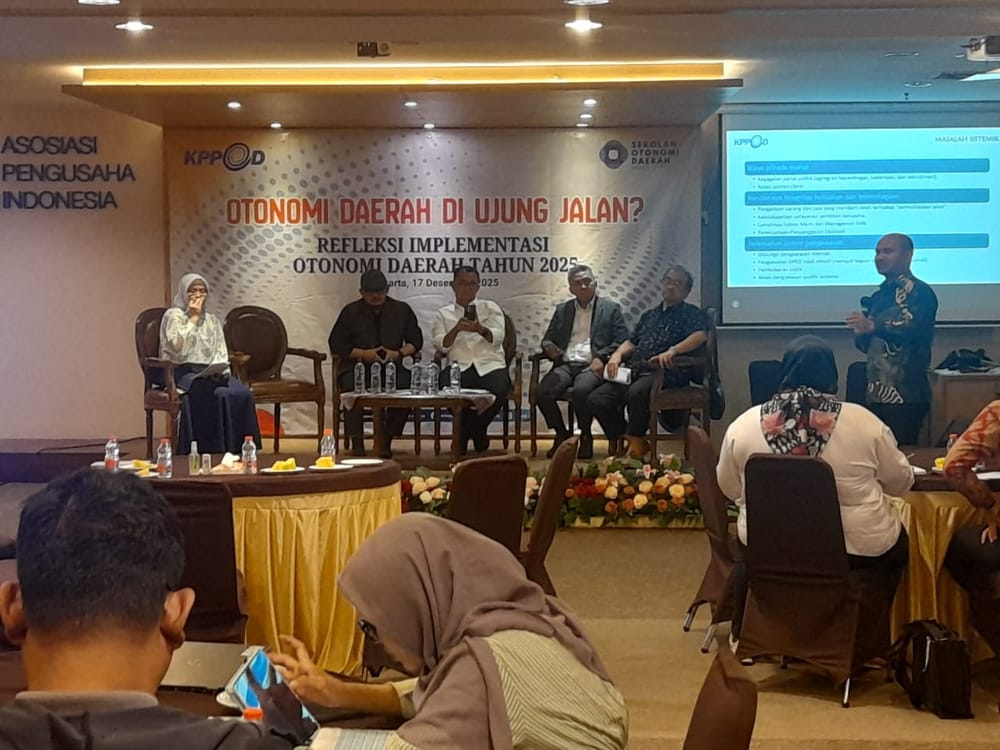Looking ahead to the last quarter of 2025, the Ministry of Finance revealed that state expenditure absorption has only reached half of the APBN outlook. In fact, there are still growth targets that must be pursued in the next three months.
For this reason, state expenditure must be accelerated, but still with careful steps and precisely targeting priority programs.
This situation was clearly explained in the September 2025 edition of the APBN Kita Press Conference at the Djuanda I Building, Ministry of Finance, Jakarta, Monday (9/22/2025). In addition to replacing the July 2025 edition press conference which was canceled at the end of last August, this event was the first opportunity for Minister of Finance Purbaya Yudhi Sadewa to explain state finances in front of journalists.
Purbaya opened the conference by explaining the impact of global economic dynamics on the Indonesian economy. According to him, amid fluctuations in commodity prices, Indonesia can maximize the manufacturing sector with three provisions.
First, the growth in manufacturing performance reached 5.68% YoY, the highest since 2022. Second, the Purchasing Manager Index has reached an expansion level of 51.5. Third, the growth in the cumulative trade balance has increased by up to 52.3% YoY.
"This is spectacular growth, showing that the global situation is not too bad. If we were afraid in the past, now we should be brave, especially since our domestic is strong. Uncertainty still exists, but we are stronger than before," said Purbaya.
Not only in terms of production, Purbaya released that Indonesia's macroeconomic situation reflects resilience. The indications are that inflation is maintained at 2.31%, investment grows 6.99%, and household consumption grows 5% YoY – mainly supported by accommodation, food and beverages, in addition to transportation and communication.
"With investor confidence that recovered very quickly after the commotion a few weeks ago, and consumer confidence in economic conditions maintained at an optimistic level, our economy will continue to be strengthened going forward. And, we will see better growth in October, November, and December," said Purbaya.
Spending Realization
Apart from the macroeconomic picture which is quite promising, state revenue and expenditure, which have only reached half of the APBN outlook, are important to highlight and underline.
Deputy Minister of Finance I Suahasil Nazara explained that as of August 31, 2025, the realization of state revenue had only reached Rp 1,638.7 trillion or 57.2% of the 2025 APBN outlook. Meanwhile, state spending realized in the same period only reached Rp 1,960.3 trillion or 55.6% of the 2025 APBN outlook.
With a deficit of Rp 321.6 trillion or 1.35% of GDP, Suahasil stated that there is still government spending that needs to be accelerated further.
In detail, of the Rp 1,960.3 trillion in state spending, ministry/agency (K/L) spending reached Rp 686 trillion or 59.1% of the APBN ceiling.
There are three types of spending that have increased. Namely, employee spending increased by 7.6% to Rp 212.8 trillion; goods spending increased by 2.4% to Rp 232.2 trillion; and social assistance spending increased by 5.5% to Rp 101.1 trillion.
This year's education budget has been absorbed by Rp 357.1 trillion or 49.3% of the APBN ceiling of Rp 724.3 trillion. The largest allocation is Rp 193.7 trillion for teachers/lecturers/educators; the construction of 100 public schools with a realization of Rp 788.7 billion; and school revitalization worth Rp 9.6 trillion.
The infrastructure budget has been absorbed by Rp 142.1 trillion, or 35.32% of the budget ceiling of Rp 402.4 trillion.
The three largest allocations are Housing Financing Liquidity Facility for 158,000 houses amounting to Rp 18.8 trillion; irrigation development worth a total of Rp 13.6 trillion, and regional road construction of Rp 10.2 trillion spread across 37 provinces. All three are priority infrastructure expenditures to support connectivity, food security and energy security.
Meanwhile, the central government's priority programs have absorbed a budget of Rp 420.2 trillion or 45.5% of the Rp 923.8 trillion ceiling. Among these, Free Nutritious Meals absorbed Rp 13 trillion or 18.3% of the state budget ceiling of Rp 71 trillion with the number of recipients reaching 22.7 million students.
In addition to MBG, the Free Health Check program in 32 hospitals has absorbed Rp 3 trillion or 32% of the state budget ceiling of Rp 9.3 trillion, and the construction of 165 new People's Schools/Garuda Superior Schools has only absorbed 4.9% of the state budget ceiling of Rp 14.4 trillion.
Specifically, Suahasil emphasized not to look at state spending from central government spending alone, but also regional spending. Until the end of August 2025, the central government had sent Rp 571.5 trillion or 62.1% of the state budget ceiling. While transfers to regions are higher than last year, regional spending is actually slower.
"We see that local government funds are still deposited in banks up to Rp 233.11 trillion. For this reason, we hope that local governments can spend faster in the next three months. This needs to be continuously encouraged to accelerate spending so that the regional budget can stimulate the regional economy," explained Suahasil.
Not only giving instructions, the central government has moved the regional economy through the transmigration area program as new growth points, providing support for cooperatives and UMKM of Rp 15.6 trillion, and regulating a 6% interest loan facility for the Merah Putih Village Cooperative with a ceiling of up to Rp 3 billion for a 6-year tenor.
Stay cautious
As time goes by, the absorption of state spending that has not been optimal is less likely to be channeled until the end of the year. Chief Economist of Bank Central Asia, David Sumual, stated that he was not surprised that absorption had not reached half of the outlook in the last quarter of the year. This is because this is a pattern that he says has been chronically occurring for many years.
"This is exacerbated by the slow progress of government flagship programs, such as MBG, Koperasi Merah Putih, and others. The way to optimize absorption is to reallocate to accelerate social assistance spending and expand demand stimulus in the 8+4+5 Package," said David when contacted by SUAR, Monday (22/9/2025).
Regardless of the slowdown, Head of the Economics Department at the Centre for Strategic and International Studies (CSIS) Indonesia, Deni Friawan, stated that the government still needs to be careful in optimizing state spending. He emphasized that while optimizing state spending is important for growth, the balance with state revenue should not be forgotten.
"If the government optimizes spending when revenue cannot be optimized, the result is an enlargement of the deficit. Moreover, with less than 3 months–4 months, it will be very difficult to reach the expenditure target of up to 100% of what has been set," Deni told SUAR.
In a situation like this, Deni is concerned that the government will rush to accelerate disbursement of this expenditure in large amounts, but not pay attention to its impact on the economy, such as spending on stationery (ATK), holding seminars or activities in hotels, and so on.
Instead of asking the government to spend hastily, Deni suggested that the efficiency spending of the state budget be re-evaluated. The financing and spending posts that the Ministry of Finance cut during Sri Mulyani Indrawati's leadership are re-entered into the budget.
"If the government wants to be quick, the expenditure posts that were previously cut must be revoked so that they can be spent immediately. The efficiency and budget cuts made at the beginning of this year must also be returned, or the cuts must be canceled," he said.
State Budget deficit widens
For next year, the Ministry of Finance said that the State Budget deficit will widen in 2026. The decision was taken in a working meeting of the DPR Budget Agency (Banggar) with the Ministry of Finance, Bappenas, and Bank Indonesia at the DPR Building, Jakarta, Thursday (18/9/2025).
In a matter of hours, the budget deficit which was originally pegged at Rp 638.8 trillion or 2.48 percent of gross domestic product (GDP), has now increased to Rp 689.1 trillion or equivalent to 2.68 percent of GDP. The additional Rp 50.3 trillion appeared as the state spending target increased.
Chairman of the DPR RI Banggar, Said Abdullah, said that the increase in the deficit was an unavoidable adjustment. "The percentage of the deficit to GDP which was initially 2.48 percent has now been adjusted to 2.68 percent, or there is an increase of 0.2 percentage points," he said.
Minister of Finance Purbaya Yudhi Sadewa emphasized that the public does not need to worry about the widening deficit. According to him, the deficit position of 2.68 percent of GDP is still within the safe range of 2–3 percent.
"So don't be afraid. We remain cautious," said Purbaya in Senayan. He added that a slightly higher deficit is needed to maintain growth momentum. "That's okay, it's needed to create growth (economic–read)," he continued.
The government hopes that with additional spending, regional development can be further encouraged, public services improved, and national strategic projects run faster. This optimism stems from the assumption that state spending has a multiplier effect on economic activity.
From the perspective of business people, the Indonesian Employers' Association (APINDO) assesses that the widening of the 2026 RAPBN deficit to a level of 2.68% of GDP cannot be seen merely as a number. Chairman of APINDO's Trade Sector, Anne Patricia, emphasized the importance of understanding the design and direction of the policies underlying the decision. According to her, the 2026 state budget must be able to balance three interests at once: maintaining fiscal sustainability, creating expansion space for the productive sector, and providing a social cushion in the midst of global uncertainty.
"This is not just a matter of choosing a full power or conservative stance. The challenge is how to keep the economic engine hot, but not overheating," she told SUAR via written statement, Sunday (21/9).
Anne admitted that the government cannot just play it safe, but also cannot be too aggressive without direction. She emphasized that the realization of 2026 growth needs to be maintained above the 5% baseline in order to open up new jobs and reduce unemployment. Therefore, the RAPBN should provide measurable acceleration space, not just maintain the status quo.
For the business world, Anne said, the key lies in execution. How quickly strategic projects can be implemented, how much incentives trigger private investment, and how real public spending generates a multiplier effect will determine fiscal credibility. "If it's just high targets without real implementation, the result is nothing more than aspiration without transformation," she asserted.
Amid global uncertainty, Anne emphasized the need to present a crowding-in effect, which is to encourage private participation and investment rather than simply relying on state spending. "Every 2026 state budget policy must be seen as an instrument to ensure that every rupiah truly becomes a multiplier engine for the national economy," she said.
Even so, widening the deficit also means the government has to seek additional financing. The financing budget has now increased from Rp 638.8 trillion to Rp 689.1 trillion. This means that fiscal space will become increasingly dependent on new debt and other financial instruments.
Echoing the business community, economists warn against taking this lightly. Yusuf Rendy Manilet, an economist from the Center of Reform on Economics (CORE), believes that deficit financing next year will most likely still rely on the issuance of government securities (SBN).
"The challenge that needs to be watched out for is the potential increase in yields due to high global uncertainty. This can increase the burden of interest payments on debt in the long term," said Yusuf.
He added that a buyback strategy for SBN with lower yields could be considered by the government when conditions allow, so that interest risk does not increasingly burden future generations.
In addition, Yusuf reminded that although the state revenue target for next year is higher than the 2025 realization projection, the increase is relatively limited. With fairly optimistic macro assumptions, failure to achieve them, for example if economic growth misses the mark, could widen the deficit beyond the government's target.
"If the macro assumptions are too optimistic and not achieved, then the government's fiscal space could become narrower, and the widening deficit could exceed the initial projection," he explained.







